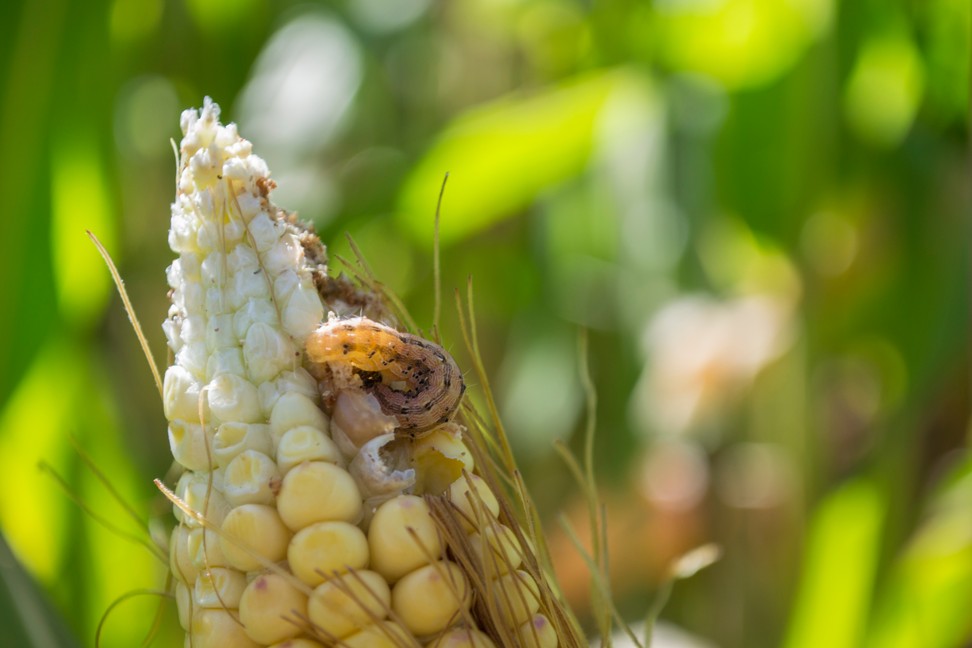
Armyworm to bite China’s under pressure food supply within two months as trade war tariffs limit US crop imports
- The pest has already attacked crops in 13 provinces and regions in southern China and is expected to move north as temperatures rise
- China has already been forced to slaughter millions of pigs with African swine fever affecting all 31 autonomous regions and provinces within just nine months
China’s domestic food security that has already been ravaged by African swine fever and is under pressure from increased tariffs from the trade war with the United States could be further hit by a devastating and rapidly spreading pest within the next two months, according to academics.
The fall armyworm has already affected farms in southern China, and could hit the country’s crop-growing heartlands in the north and northeast as temperatures rise, increasing the risks to crop production as Chinese tariffs restrict the country’s ability to purchase American crops as replacements.
China has already been forced to slaughter millions of pigs with African swine fever affecting all 31 autonomous regions and provinces within just nine months, trimming 20 per cent of the national supply and driving up prices.
And the trade tariffs imposed by China last week restrict purchase of US agriculture products, including pork, soybeans and corn.

The armyworm could now spread to the north and northeastern regions of the country as early as July, according to Hu Gao, professor of Entomology at the Nanjing Agricultural University, vastly expanding the damage that has been inflicted so far on 13 provinces and regions south of the Yangtze River, including Yunnan, Sichuan, Chongqing, Guangxi, Guizhou, Guangdong, Jiangxi, Hubei, Hunan, Zhejiang, Fujian and Hainan.
“The impact has been greatest in Guangxi,” said Hu. “The crops there have been attacked most.”
According to the National Agricultural Technology Extension Service Centre, an affiliate of the Ministry of Agriculture and Rural Affairs, 72,000 hectares (177,915 acres) of agriculture produce, primarily corn and a smaller volume of sugar cane, have already been ruined.
It warned that the rapid spread of the armyworm threatened to destroy the summer corn harvest in the northern regions, especially the Huang Huai Hai area that covers Beijing, Tianjin and Shandong province, which is known to produce the best quality corn.
At present, the scale of the fall armyworm’s infestation has been huge, its spread has been rapid, its destruction severe, and monitoring and prevention are very difficult.
“At present, the scale of the fall armyworm’s infestation has been huge, its spread has been rapid, its destruction severe, and monitoring and prevention are very difficult,” the centre said.
The fall armyworm, native to regions ranging from Argentina to northern Canada, was first detected in China five months ago after wreaking havoc in Africa over the past two years having infested up to at least half of the continent’s crops.
A United States Department of Agriculture (USDA) report published at the end of April, citing unnamed experts, said the pest, which entered Yunnan province from the neighbouring country of Myanmar, would spread to all of China’s grain producing regions within 12 months.
“[The fall armyworm] has no natural predators in China and its presence may result in lower production and crop quality of corn, rice, wheat, sorghum, sugar cane, cotton, soybean, and peanuts among other cash crops,” said the USDA report.
A potentially looming disaster for crop quality and output would force China to import more from foreign markets, even as the government’s 25 per cent tariff on key crop imports virtually eliminates any ability to import from the US.
China’s agriculture ministry planned to expand the amount of land used to grow soybeans and other oilseeds by 330,000 hectares (815,447 acres) this year to reduce the country’s reliance on imports. It also predicted a rise in the shortfall between domestic corn output and consumption from October 2018 to September 2019 to 28 million tonnes, compared with 11 million tonnes a year earlier.
Corn is central to the global agriculture complex, any deficit in China will necessitate additional imports having wide-ranging ripple effects globally.
“Corn is central to the global agriculture complex, any deficit in China will necessitate additional imports having wide-ranging ripple effects globally,” said John Reeve, director of Agree Commodities, an agriculture product trading firm.
The fall armyworm feeds on about 180 different types of crops while in its caterpillar phase, with its favourite being corn, according to Nanjing Agricultural University’s Hu.
Hu and his team of scientists began tracking the pest’s geographical spread in May last year after it hit India. The team predicted the pest will reach China’s northern plains via two routes, from the east and the west, according to Chinese media reports.

The western route comes from Myanmar and makes its way from Yunnan across to the northern Shanxi and Shaanxi provinces, while the eastern path begins in Vietnam and Laos and enters the provinces of Guangdong and Guangxi, riding on strong southwesterly winds to reach beyond the Yangtze and Huai rivers to land in the northeastern plains.
The USDA report said China’s agriculture ministry has been taking emergency measures to monitor and control the spread of the fall armyworm with a national crop protection monitoring and surveillance programme in each local agricultural bureau to implement a trapping and scouting scheme.
The Chinese Academy of Agricultural Sciences is also collaborating with domestic and foreign crop protection companies to identify appropriate chemical and non-chemical control measures, it said.

